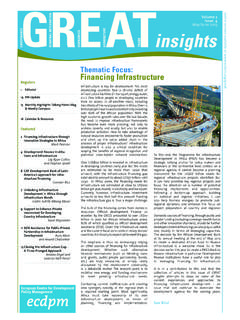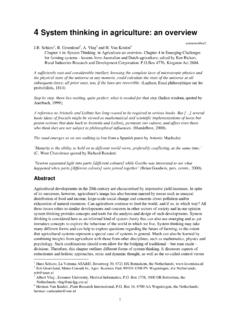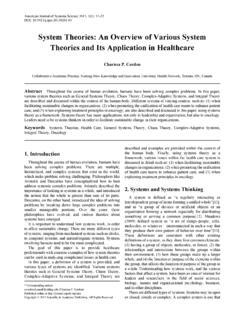Transcription of THE IDEA AND PRACTICE OF SYSTEMS THINKING …
1 THE IDEA AND PRACTICE OF SYSTEMS . THINKING AND THEIR RELEVANCE FOR. CAPACITY DEVELOPMENT. Peter Morgan European Centre for Development Policy Management March 2005. CONTENTS. 1 Introduction ..2. 2 A Brief overview of SYSTEMS 3 An overview of Some Key SYSTEMS Issues and 4 Operational Implications of SYSTEMS THINKING for Capacity 5 General Challenges to the Use of SYSTEMS THINKING ..27. 6 End Annex 1 - Annex 2 - Four Approaches to SYSTEMS THINKING ..32. 1. 1 Introduction The European Center for Development Policy Management (ECDPM) is engaged in a research project on the issues of capacity, change and performance sponsored by the GOVNET. (Governance and Capacity Development Network) of the Development Assistance Committee (DAC). of the Organization for Economic Cooperation and Development (OECD) in The purpose of the research is to contribute to the on-going debate on capacity and capacity development that is taking place around the world in both high and low income countries.
2 We are giving particular attention to clarifying the nature of capacity and how it emerges, declines or sustains itself in a variety of settings. We are also exploring both the explicit and tacit mental models that people use to think about DFID and some other international funding agencies are using a political economy view and analyzing the way societal structures and institutions shape the capacity and performance of organizational actors. Economists emphasize the power of market forces to influence capacity development. Supply and demand and incentives in the context of individual and organizational choice is highlighted. NGOs tend to focus on the perspective of organizational development and the ways in which participation, commitment and empowerment can be key forces for capacity development. Other international development agencies that are more oriented toward technical subjects see knowledge management as an essential part of any change strategy.
3 Enhancing skill levels at the individual and organizational levels is key from this perspective. One other mental model that is getting more attention - again - is that of SYSTEMS THINKING . A. large body of writing and experience exists on SYSTEMS THINKING and acting. Some of this has been applied in the private Its influence is starting to be more apparent in the But to date, SYSTEMS THINKING has been used in a very limited way in development It usually appears under the label of systemic approaches' and is focused on the analysis of inter-organizational issues. To date, we have found few analyses that apply SYSTEMS THINKING to capacity issues. This paper has been prepared as background for a workshop held at ECDPM in Maastricht March 16-17, 2005, on the subject of SYSTEMS THINKING and its relevance for capacity development. It gives an general overview of the main issues and explores the utility of SYSTEMS THINKING for improving our understanding of capacity issues.
4 Readers should understand this is not an advocacy paper. Its goal is not to promote the value of SYSTEMS THINKING or to suggest a particular set of tools or frameworks. It offers no recommendations. It is not suggesting that SYSTEMS THINKING offers a complete perspective on capacity issues. The point here is explanation and exploration of the basic ideas connected with SYSTEMS THINKING . If the workshop discussions see it as contributing some potential value, more work will need to craft these ideas to apply to capacity issues. Some questions are included at the end of the main sections for use in discussion. More specifically, the paper tries to address the following questions: What is SYSTEMS THINKING ? Are there different types of SYSTEMS THINKING ? What are the main concepts? How would these relate to capacity development? 1. Readers wishing to know more about the ECDPM research may wish to consult the website at 2. Mental models are conceptual structures in the mind that drive cognitive processes of understanding.
5 They influence people's actions because they mould people's appreciation of what they see. People therefore observe selectively. Mental models most often invisibly define our relationship with each other and with the world in which we find mental models can undermine and limit the vision of what can be seen and done Peter Senge, The Fifth Discipline, Chap. 10 Mental Models . 3. See Peter Senge, The Fifth Discipline: The Art and PRACTICE of the Learning Organization, 1990. 4. See Jake Chapman, system Failure: Why Governments must learn to think differently, DEMOS, 2004. 5. See Paul Engel, The social organization of innovation: a focus on stakeholder interaction, 1997 Also Samir Rihani, Complex SYSTEMS Theory and Development PRACTICE , Understanding non-linear realities, Zed Books, 2002. 2. What are the advantages of SYSTEMS THINKING ? What value, if any, would it add to what we already know or do? What are the limitations? Is SYSTEMS THINKING a fundamentally new and different way of THINKING about capacity issues or is it just another perspective to combine with existing approaches?
6 Is it feasible for practitioner groups and organizations to use it? What are the operational implications? A further qualification is needed here. To date, most SYSTEMS analysis in development cooperation has focused on one issue in particular: that is, the functioning of large organizational and institutional SYSTEMS and networks and how donors can better address The basic idea here is that any capacity intervention in such SYSTEMS must be based on a theory of action that includes working with a range of organizations and institutions. This view applies especially to the levels'. above that of single organizations. The debate about how best to structure SWAps and program support is the most obvious example. This paper has a different focus. It looks mainly at three other issues connected to SYSTEMS THINKING . The first is that of SYSTEMS THINKING itself as a particular analytical and learning technique that can be applied in almost any situation. In this sense, SYSTEMS THINKING can apply to any human activity at any level'.
7 The second issue is that of human SYSTEMS as an organizational form and an object or theater of SYSTEMS THINKING . Such SYSTEMS can also operate at any level of development activity ranging from the individual to the national. All organizations, for example, are SYSTEMS by nature. So are families, ethnic and tribal groups, soccer teams, church choirs, organizational sub-units, restaurants and banking SYSTEMS . Large SYSTEMS are an important but not exclusive part of this analysis. The third issue is that of capacity and capacity development and the ways in which SYSTEMS THINKING can help us to better understand its nature and dynamics. What this paper is trying to understand is the potential contribution which SYSTEMS THINKING and SYSTEMS acting could make to capacity development. Readers should also realize that some of the writing associated with SYSTEMS THINKING is unconventional ranging from the mundane to the metaphysical. Insights come from a variety of non- traditional sources including quantum physics, evolutionary biology and religion.
8 These may or may not be engaging for many people used to sector strategies and result matrices but they are useful to inject some fresh air into our THINKING . Those of us still using the linear, mechanical, machine building approach to capacity development need to suspend judgment, at least for a while, before dismissing the whole exercise of SYSTEMS THINKING . Those who are allergic to theory of any kind also need to take a deep breath. A word about capacity. We do not want to get into yet another fruitless effort to define'. capacity and capacity development. In this paper, we have used the term capacity' to mean some sort of ability to perform or to create or deliver value. In many ways, capacity is about the potential to act as opposed to performance which is about execution or implementation. In this paper, we use the term capacity' as referring to the overall ability of a system to perform. The term capability' refers to a more specific collective ability to do something more specific such as learning.
9 Competence' refers to individual ability or mastery. Finally, we would add that this paper is intended as a general summary of the SYSTEMS THINKING issue. For the purposes of explanation, it uses a few examples from the ECDPM case research. But it is not an effort to rethink the results of those cases from a SYSTEMS perspective. 6. See UNDP, Capacity Assessment and development in a SYSTEMS and Strategic Management Context, January 1998. 3. 2 A Brief overview of SYSTEMS THINKING This paper sees SYSTEMS THINKING as a way of mentally framing what we see in the world. It is a way of THINKING that looks at the whole' first with its fit and relationship to its environment as a primary concern. Attention to the constituent elements or parts of the system is secondary. SYSTEMS THINKING is more an orientation or a perspective than it is a formula or prescription. It can be used to help people understand how SYSTEMS work and how people can deal with them more effectively.
10 It is a way of exploring real life rather than representing it. It is a technique to figure out what's going on. It encourages people to look for patterns of interaction and underlying structures that shape the emergent patterns of SYSTEMS behavior. A corollary to this approach is the idea that structures matter much more than individual events in terms of determining outcomes. The focus of SYSTEMS THINKING moves in a variety of different directions compared to the linear style of conventional THINKING . It is more than lateral THINKING . It is also vertical and horizontal and circular. SYSTEMS THINKING pays much more attention to movement and dynamics. SYSTEMS THINKING is oriented more towards capturing flow and movement. In particular, it focuses on processes, patterns and relationships. What matters more is understanding the effects of the interactions as opposed to detailed efforts to predict outcomes. SYSTEMS THINKING also assumes a good deal of randomness and unanticipated consequences that cannot be foreseen even under the most laborious exercises in risk analysis.



















